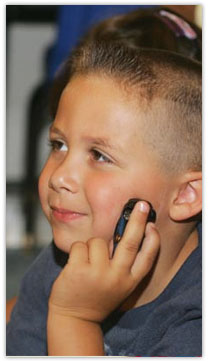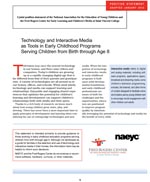Technology and Young Children: School-Age Children

You are here
Effective Classroom Practice: School-Age Children
 Selected Examples of Effective Classroom Practice Involving Technology Tools and Interactive Media (PDF)
Selected Examples of Effective Classroom Practice Involving Technology Tools and Interactive Media (PDF)
It is during the early school-age years that children begin to use the tools of their society with competence. In our culture, that typically means learning to read and write, calculate, and investigate. Children use books, touch screens, writing instruments, and tools for studying scientific and social concepts. As digital technologies increasingly become the tools that older children and adults use in their work and home lives, younger children seek to emulate this usage, first through imitation and representational play and then later through mastery of the tools for their own self-expression and learning. New web-based technologies allow the child to be the producer of the technology, adding to the appropriateness, motivation, and usability of technology tools.
Technology Tools and Interactive Media
- Explore a wide range of quality interactive media experiences, on a variety of platforms. These include literacy software, games, and technologies that go beyond drill and practice and foster creativity.
- Use Web 2.0 tools for writing, collaboration, and playful experimentation.
- Include a range of assistive technology devices to expand access for children with special needs.
- Include language-translation software and keyboard adaptations for dual language learners.
- Provide geometry software that allows children to explore the concept of shape by stretching, bending, shrinking, or combining images.
- Use interactive digital games as a way to explore math, reading, social studies, and science concepts.
- Provide digital microscopes and other digital tools for investigation.
- Encourage children to become proficient in using digital tools such as cameras, scanners, recorders, and editing software.
- Use technology tools to connect with other children in their communities or globally using e-mail, blogs, or video conferencing.
- Integrate the International Society for Technology in Education (ISTE) standards into the curriculum. (See www.iste.org/libraries/PDFs/NETS_for_Teachers_2008_EN.sflb.ashx).
- Record children’s stories about their art projects, activities, and interactions;make digital audio or video files to document their progress.
- Incorporate assistive technologies as appropriate for children with special needs and/or developmental delays
Technology and Interactive Media as Tools in Early Childhood Programs Serving Children from Birth through Age 8
A joint position statement issued by the National Association for the Education of Young Children and the Fred Rogers Center for Early Learning and Children's Media at Saint Vincent College
